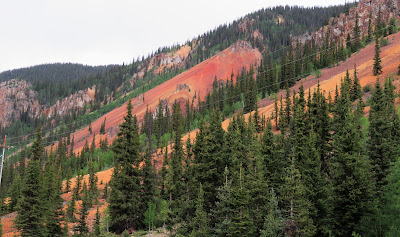 Irontown
Following abandonment, many of the prospects, mines, and mills surrendered to the pressures of mineral exploration, scavenging, recreational use, and especially natural decay, leaving a number of mines and mining towns in various states of preservation.
While some of the important mines and towns are well-known, forgotten mines and mining towns are being rediscovered through historic preservation efforts, environmental cleanup, and greater attention to local and Federal public lands.
Irontown
Following abandonment, many of the prospects, mines, and mills surrendered to the pressures of mineral exploration, scavenging, recreational use, and especially natural decay, leaving a number of mines and mining towns in various states of preservation.
While some of the important mines and towns are well-known, forgotten mines and mining towns are being rediscovered through historic preservation efforts, environmental cleanup, and greater attention to local and Federal public lands.
Jul 14, 2018
Million Dollar Highway: June 13; 2018: Silverton and Ouray on San Juan Skyway
Silverton and Ouray are on US 550, the famed "Million Dollar Highway" that connects Durango and Ouray, passing through incredible mountain scenery and over several high passes.
The canyon-clinging road Silverton and Ouray is called “The Million Dollar Highway” either because it cost so much to build or the amount of gold ore that remained in the roadway’s fill.
In terms of mining history, San Juan County is among the most important regions in the Rocky Mountain states. The county hosted a local mining industry that was significant for its longevity, productivity, role in key industry events, and association with important people.
In 1860, the Animas River drainage (which includes Silverton) was the scene of the first popular gold rush in southwestern Colorado. This initial event led to the exploration and popularization of the San Juan Mountains.
During the late 1870s, hardrock mining took hold and became important enough to convince the Denver & Rio Grande Railroad to grade a narrow-gauge line to the San Juans and then up to Silverton. The railroad is still in service today as one of Colorado’s premiere tourist attractions, designated a National Historic Landmark in July 1961.
Saloons, alcohol, prostitution, gambling, robbery, there were many opportunities to die violently in the mining days of Silverton. Suicides were not uncommon, especially among the prostitutes. Also in the early years of the town there were a few lynchings by the local vigilantes.
Mining was a very dangerous occupation with few, if any, safety precautions on the part of the mine owners. Mining casualties were frequent - falling down an open shaft, being blown to pieces in a powder explosion or the mine itself caving in on the workers. Snowslides carried many to eternity.
Leaving Ouray for Silverton. Ouray Main Street.
The Million Dollar Highway.
An abandonned mining town: Irontown.
Irontown
Irontown
 Irontown
Following abandonment, many of the prospects, mines, and mills surrendered to the pressures of mineral exploration, scavenging, recreational use, and especially natural decay, leaving a number of mines and mining towns in various states of preservation.
While some of the important mines and towns are well-known, forgotten mines and mining towns are being rediscovered through historic preservation efforts, environmental cleanup, and greater attention to local and Federal public lands.
The Million Dollar Highway.
Silverton, Colorado
Silverton Details
Elevation: 9,305 Feet (2,836 meters)
Date Settled: 1874
Current Population: 700
Peak Population: 5,000
Primary Mineral: Gold, Silver
Silverton History
In the summers Ute Indians hunted and lived in the Silverton area before the first explorers, the Spanish, arrived. The Utes remained until 1873 when the Brunot Treaty opened the San Juans to settlement. The first permanent white settlers came for diverse reasons, but gold and silver served as magnets to the region. Some also wished to escape cumbersome responsibilities, perhaps even crimes, and turn over a new leaf. Others hoped to earn enough money to send for their families that they might all embark on a better life.
SILVERTON During the late 1870s, hardrock mining took hold and became important enough to convince the Denver & Rio Grande Railroad to grade a narrow-gauge line to the San Juans and then up to Silverton. The railroad is still in service today as one of Colorado’s premiere tourist attractions, designated a National Historic Landmark in July 1961. Most of the early settlers came from states east of Colorado, but the middle 1880s saw large numbers come from Europe, Austria, Italy, Serbia, Croatia, Cornwall, Ireland, Wales, France, Germany, Russia, Norway, Sweden, Finland, Denmark and elsewhere. The mining companies advertised in foreign newspapers, promising jobs and the opportunity to own land. Foreigners, usually the men first, made the exhausting ocean voyage, usually crowded into the lower levels of often dirty ships, then after finally arriving in America crossed half a continent to reach Silverton. Few could speak English, and most left their families in the old country, worked in the mines, saved their money, then sent for their loved ones.
SILVERTON Early day Silverton was rough, turbulent and often violent. The environment was extremely harsh, especially the long severe winters. Mining was a very dangerous occupation with few, if any, safety precautions on the part of the mine owners. Mining casualties were frequent - falling down an open shaft, being blown to pieces in a powder explosion or the mine itself caving in on the workers. Snowslides carried many to eternity. Saloons, alcohol, prostitution, gambling, robbery, there were many opportunities to die violently. Suicides were not uncommon, especially among the prostitutes. Also, in the early years of the town, there were a few lynchings by the locals.
The Congregational Church was dedicated in 1881, the railroad reached Silverton the next year, and the Grand Hotel (later the Grand Imperial, still in operation) had its grand opening in 1883. Silverton's population was 3,000, and the town was becoming civilized! Fraternal lodges and various literary societies were organized. In the early 1900s the Carnegie Library, County Court House, County Jail, Town Hall, Wyman Building, Benson Block, Bausman Building, Miners Union Hall and Miners Union Hospital were built.
Silverton.
Today tourism is the main business in the area,
The San Juan Skyway is very popular among retirees driving their Harley Davidson motorbikes.
Red Mountain
Red Mountain Mining
Red Mountain
Red Mountain Mining
Red Mountain Mining
Ouray, Male Broad-tailed Hummingbird, the most common of Colorado’s Four species of Hummingbirds. Their distinctive metallic shrill brings smiles to every hummingbird lover.
Ouray
Ouray
Irontown
Following abandonment, many of the prospects, mines, and mills surrendered to the pressures of mineral exploration, scavenging, recreational use, and especially natural decay, leaving a number of mines and mining towns in various states of preservation.
While some of the important mines and towns are well-known, forgotten mines and mining towns are being rediscovered through historic preservation efforts, environmental cleanup, and greater attention to local and Federal public lands.
The Million Dollar Highway.
Silverton, Colorado
Silverton Details
Elevation: 9,305 Feet (2,836 meters)
Date Settled: 1874
Current Population: 700
Peak Population: 5,000
Primary Mineral: Gold, Silver
Silverton History
In the summers Ute Indians hunted and lived in the Silverton area before the first explorers, the Spanish, arrived. The Utes remained until 1873 when the Brunot Treaty opened the San Juans to settlement. The first permanent white settlers came for diverse reasons, but gold and silver served as magnets to the region. Some also wished to escape cumbersome responsibilities, perhaps even crimes, and turn over a new leaf. Others hoped to earn enough money to send for their families that they might all embark on a better life.
SILVERTON During the late 1870s, hardrock mining took hold and became important enough to convince the Denver & Rio Grande Railroad to grade a narrow-gauge line to the San Juans and then up to Silverton. The railroad is still in service today as one of Colorado’s premiere tourist attractions, designated a National Historic Landmark in July 1961. Most of the early settlers came from states east of Colorado, but the middle 1880s saw large numbers come from Europe, Austria, Italy, Serbia, Croatia, Cornwall, Ireland, Wales, France, Germany, Russia, Norway, Sweden, Finland, Denmark and elsewhere. The mining companies advertised in foreign newspapers, promising jobs and the opportunity to own land. Foreigners, usually the men first, made the exhausting ocean voyage, usually crowded into the lower levels of often dirty ships, then after finally arriving in America crossed half a continent to reach Silverton. Few could speak English, and most left their families in the old country, worked in the mines, saved their money, then sent for their loved ones.
SILVERTON Early day Silverton was rough, turbulent and often violent. The environment was extremely harsh, especially the long severe winters. Mining was a very dangerous occupation with few, if any, safety precautions on the part of the mine owners. Mining casualties were frequent - falling down an open shaft, being blown to pieces in a powder explosion or the mine itself caving in on the workers. Snowslides carried many to eternity. Saloons, alcohol, prostitution, gambling, robbery, there were many opportunities to die violently. Suicides were not uncommon, especially among the prostitutes. Also, in the early years of the town, there were a few lynchings by the locals.
The Congregational Church was dedicated in 1881, the railroad reached Silverton the next year, and the Grand Hotel (later the Grand Imperial, still in operation) had its grand opening in 1883. Silverton's population was 3,000, and the town was becoming civilized! Fraternal lodges and various literary societies were organized. In the early 1900s the Carnegie Library, County Court House, County Jail, Town Hall, Wyman Building, Benson Block, Bausman Building, Miners Union Hall and Miners Union Hospital were built.
Silverton.
Today tourism is the main business in the area,
The San Juan Skyway is very popular among retirees driving their Harley Davidson motorbikes.
Red Mountain
Red Mountain Mining
Red Mountain
Red Mountain Mining
Red Mountain Mining
Ouray, Male Broad-tailed Hummingbird, the most common of Colorado’s Four species of Hummingbirds. Their distinctive metallic shrill brings smiles to every hummingbird lover.
Ouray
Ouray
 Irontown
Following abandonment, many of the prospects, mines, and mills surrendered to the pressures of mineral exploration, scavenging, recreational use, and especially natural decay, leaving a number of mines and mining towns in various states of preservation.
While some of the important mines and towns are well-known, forgotten mines and mining towns are being rediscovered through historic preservation efforts, environmental cleanup, and greater attention to local and Federal public lands.
Irontown
Following abandonment, many of the prospects, mines, and mills surrendered to the pressures of mineral exploration, scavenging, recreational use, and especially natural decay, leaving a number of mines and mining towns in various states of preservation.
While some of the important mines and towns are well-known, forgotten mines and mining towns are being rediscovered through historic preservation efforts, environmental cleanup, and greater attention to local and Federal public lands.
Subscribe to:
Post Comments (Atom)


















No comments:
Post a Comment